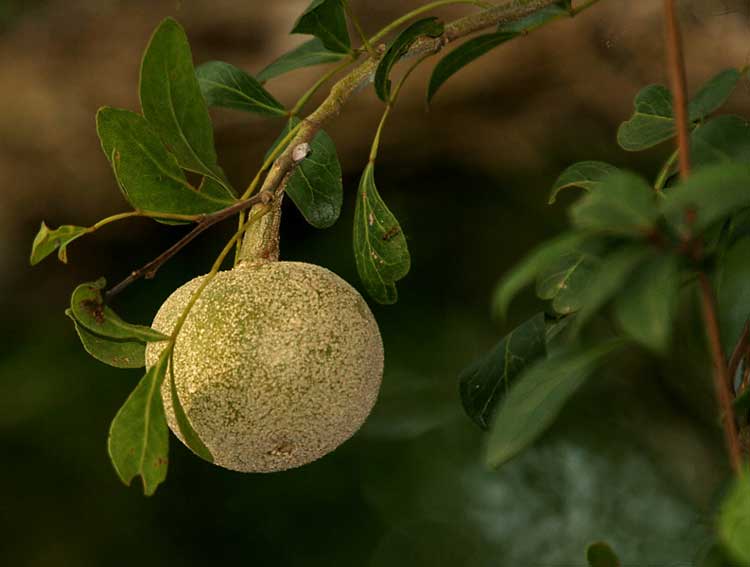
Limonia acidissima (*)
Classification System: APG IV
Superregnum: Eukaryota
Regnum: Plantae
Cladus: Angiosperms
Cladus: Eudicots
Cladus: Core eudicots
Cladus: Rosids
Cladus: Eurosids II
Ordo: Sapindales
Familia: Rutaceae
Subfamilia: Aurantioideae
Tribus: Aurantieae
Genus: Limonia
Species: Limonia acidissima
Name
Limonia acidissima L. Sp. PL. ed 2 1: 654. (1762)
Synonyms
Homotypic
Hesperethusa acidissima (L.) M.Roem.
Heterotypic
Schinus limonia L. in Sp. Pl. ed. 1: 389. (1753)
Feronia elephantum Corrêa in Act. soc. Linn. Lond. 5 (1800), 224
Feronia limonia Swingle in Journ. Wash. Acad. Sci. 4, 328 (1914)
Limonia elephantum Panigrahi in Taxon 26, 577 (1977)
Crateva balangas K.D.Koenig
Crateva vallanga J.Koenig ex Wight & Arn.
Anisifolium curvispina (Miq.) Kuntze
Anisifolium limonia Kuntze
Anisifolium spectabile (Miq.) Kuntze
Feronia balanghas (K.D.Koenig) Steud.
Hesperethusa ambigua M.Roem.
Limonia ambigua DC.
Limonia curvispina Miq.
Limonia dulcis J.F.Gmel.
Limonia engleriana Perkins
Limonia pinnatifolia Houtt.
Limonia spectabilis Miq.
Murraya odorata Blanco
Limonia acidissima, William Roxburgh
References
Linnaeus, C. 1762. Species Plantarum, ed. 2, Tomus I: 554. Reference page.
Govaerts, R. et al. 2021. Limonia acidissima in Kew Science Plants of the World online. The Board of Trustees of the Royal Botanic Gardens, Kew. Published online. Accessed: 2021 Feb. 28. Reference page.
International Plant Names Index. 2021. Limonia acidissima. Published online. Accessed: Feb. 28 2021.
USDA, ARS, Germplasm Resources Information Network. Limonia acidissima in the Germplasm Resources Information Network (GRIN), U.S. Department of Agriculture Agricultural Research Service. Accessed: 07-Oct-06.
Vernacular names
বাংলা: কৎবেল, কয়েতবেল
English: wood-apple, elephant-apple
हिन्दी: कबिट
ಕನ್ನಡ: ಬೆಳವಲ
मराठी: कवठ
ଓଡ଼ିଆ: କଇଥ
தமிழ்: விளா
తెలుగు: వెలగ
Limonia acidissima is the only species within the monotypic genus Limonia. Common names for the species in English include wood-apple and elephant-apple.[3]
Description
Limonia acidissima is a large tree growing to 9 metres (30 ft) tall, with rough, spiny bark. The leaves are pinnate, with 5-7 leaflets, each leaflet 25–35 mm long and 10–20 mm broad, with a citrus-scent when crushed. The flowers are white and have five petals. The fruit is a berry 5–9 cm diameter, and may be sweet or sour. It has a very hard rind which can be difficult to crack open, it appears greenish-brown in colour from outside and contains sticky brown pulp and small white seeds. The fruit looks similar in appearance to the Bael fruit (Aegle marmelos). It contains considerable amount of protein, carbohydrate, iron, fat, calcium, Vit-B & C etc. 100 g of ripe fruit pulp contains up to 49 KCal.
Woodapple fruit
Opened woodapple fruit
A glass of woodapple juice
Taxonomy
A number of other species formerly included in the genus are now treated in the related genera Atalantia, Citropsis, Citrus, Glycosmis, Luvunga, Murraya, Micromelum, Naringi, Pamburus, Pleiospermium, Severinia, Skimmia, Swinglea, and Triphasia.[4]
Distribution
Limonia acidissima is native to India (including the Andaman Islands), Bangladesh, and Sri Lanka.[5][6] The species has also been introduced to Indochina and Malesia.[6][5]
Uses
This section needs additional citations for verification. Please help improve this article by adding citations to reliable sources. Unsourced material may be challenged and removed. (June 2019) (Learn how and when to remove this template message)
The fruit is used to make a fruit juice with astringent properties and jams. Ripe fruit can be used as pickle (mashed with green chili pepper, sugar and salt only).[7] Another species of this fruits are considered auspicious to be offered to Shiva and Ganesha in pujas. A majority of Hindu temples will have a sacred tree within its compound and is known as the Sthala Vriksha.
In Myanmar, the wood is used to make the distinctive local face cream thanaka.[8]
Nutrition
Woodapple, raw (Daily Value)
| Nutritional value per 100 g (3.5 oz) | |
|---|---|
| Energy | 518.816 kJ (124.000 kcal) |
|
Carbohydrates
|
18.1 g
|
| Sugars | 0 g |
| Dietary fiber | 5 g |
|
Fat
|
3.7 g
|
|
Protein
|
7.1 g
|
| Vitamins | Quantity
%DV†
|
| Thiamine (B1) |
3%
0.04 mg |
| Riboflavin (B2) |
1417%
17 mg |
| Niacin (B3) |
53%
8 mg |
| Vitamin C |
4%
3 mg |
| Minerals | Quantity
%DV†
|
| Calcium |
13%
130 mg |
| Iron |
46%
6 mg |
| Manganese |
857%
18 mg |
| Zinc |
105%
10 mg |
| Other constituents | Quantity |
| Water | 64.2 g |
|
in Fruit Wood Apple values are for edible portion
|
|
|
|
| †Percentages are roughly approximated using US recommendations for adults. Source: 1 |
|
References
"Limonia L." Plants of the World Online. Royal Botanic Gardens, Kew. Retrieved 2021-09-14.
"Limonia acidissima L." Plants of the World Online. Royal Botanic Gardens, Kew. Retrieved 2021-09-14.
"Limonia acidissima". Germplasm Resources Information Network (GRIN). Agricultural Research Service (ARS), United States Department of Agriculture (USDA). Retrieved 2016-04-03.
John H. Wiersema (2005-02-22). "Species in GRIN for genus". Ars-grin.gov. Archived from the original on 2000-11-02. Retrieved 2011-04-19.
"Limonia acidissima L." Plants of the World Online. Royal Botanic Gardens, Kew. Retrieved 2018-03-25.
Smith, Albert C. (1985). Flora Vitiensis nova : a new Flora of Fiji (spermatophytes only). Vol. 3. Lawaii, Hawaii: Pacific Tropical Botanical Garden. pp. 526–527. Retrieved 2018-03-25 – via Biodiversity Heritage Library, digitized by Smithsonian Libraries.
Jaya Surya Kumari Manthena and K. Mythili (2004). "Development of wood apple pickle". Int. J. Food Safety, Nutrition and Public Health, Vol. 5, No. 1, 2014. Retrieved 2019-06-09.
Köllner, Helmut; Bruns, Axel (1998). Myanmar (Burma). Hunter Publishing. p. 18. ISBN 9783886184156. Retrieved 2021-05-08.
Retrieved from "http://en.wikipedia.org/"
All text is available under the terms of the GNU Free Documentation License


